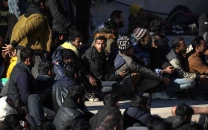Explainer: Why are Chinese and Indian troops fighting in a remote Himalayan valley?
The area lies at an altitude of about 14,000 feet and temperatures often fall below zero degrees Celsius

The area lies at an altitude of about 14,000 feet (4,250 metres) and temperatures often fall below zero degrees Celsius.
PHOTO: REUTERS
China has not given any details of casualties.
Where was the latest fighting?
The clashes took place in the Galwan region of Ladakh, in the western Himalayas, where Indian and Chinese forces have been facing off since early May.
The disputed site lies amid remote, jagged mountains and fast flowing rivers on the northern tip of India, abutting the Aksai Chin plateau, a Chinese administered area claimed by India.
The area lies at an altitude of about 14,000 feet and temperatures often fall below zero degrees Celsius.
China says it does not want to see any more clashes on border with India
A 1993 agreement between the two countries stipulates that neither side shall use force at the Line of Actual Control (LAC), the de facto border. But violent, high-altitude disputes have erupted several times without any shots being fired.
Why did clashes erupt now?
Both countries claim vast swathes of each other’s territory along their 4,056km Himalayan border. Some disagreements are rooted in demarcations made by India’s former British colonial administrators.
Military experts say one reason for the current face-off is that India has been building roads and airfields to improve transport links and narrow the gap with China’s superior infrastructure on its side of the LAC.
At Galwan, India completed a road leading to an airfield in October despite Chinese objections. India says it is operating on its side of the LAC.
What has happened in the past?
The deaths were the first since hundreds died on both sides in a major border clash in 1967 between the nuclear-armed neighbours, which are the world’s two most populous countries.
India and China fought a brief war in Ladakh and in northeastern India in 1962. Mutual distrust has occasionally led to flare-ups since. Infrastructure work near or within disputed territories is frequently followed by increased tension.
The LAC largely follows a ceasefire line after the 1962 war, but the two sides disagree on where it lies.
The last major dispute was in 2017 on the remote Doklam plateau near the borders of India, Bhutan and China. After a tense standoff, both sides agreed to an “expeditious disengagement” of troops, according to India’s foreign ministry.



















COMMENTS
Comments are moderated and generally will be posted if they are on-topic and not abusive.
For more information, please see our Comments FAQ